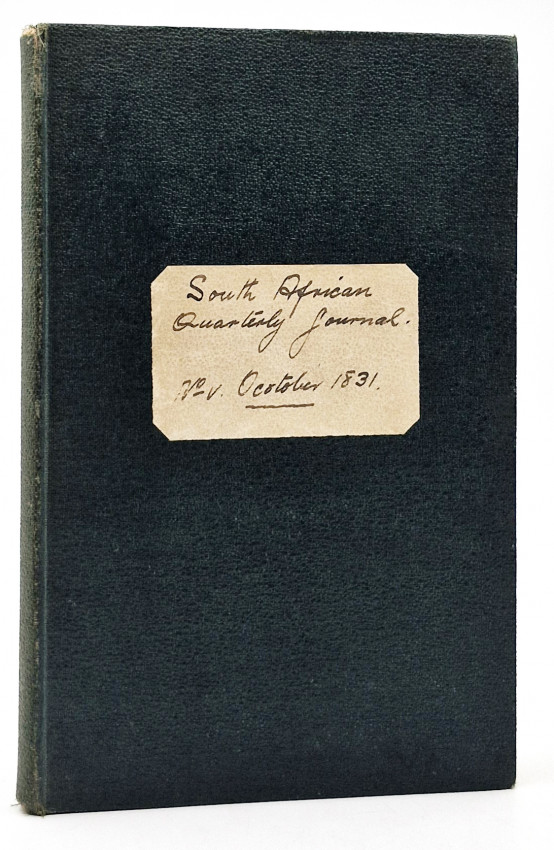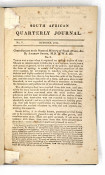Pages 9 to 24, bound in contemporary pebble-grained cloth with a paper title label on the upper cover.
'Born: 3 December 1797, Kirktoun parish, Roxburghshire, United Kingdom.
'Died: 11 August 1872, London, United Kingdom.
'Active in: SA. Dr Andrew Smith
'Andrew Smith, British army surgeon and naturalist, completed his schooling at age 15. From 1813 to 1815 he was apprenticed part-time to a medical doctor while studying medicine at the University of Edinburgh. In August 1815 he became the youngest officer ever to be admitted to the Medical Department of the British Army and was appointed as a hospital assistant. During the next three he years received further training at Fort Pitt, Chatham, and was allowed also to continue his studies at the London Infirmary for Curing Diseases of the Eye. In 1818 he was transferred to Edinburgh where he was attached to the 79th Highlanders, but was given an opportunity to complete his medical studies. He graduated as Doctor of Medicine (MD) in August 1819 with a thesis on a mild form of smallpox, De variolis secondariis. That same year he was elected a Fellow of the Wernerian Society of Edinburgh and published a paper on "A case of malformation of the kidneys" in the Edinburgh Medical and Surgical Journal. He never formally studied zoology, to which he later made major contributions.
'After serving as a hospital assistant for short periods in Quebec, Nova Scotia and Malta he was sent to the Cape Colony, arriving in Simon's Bay on 12 August 1821. Proceeding to the eastern frontier of the colony he was stationed in Grahamstown and later at Fort Willshire (south-east of Fort Beaufort) until the middle of 1825. During these years he made a study of the natural history of the frontier region and the customs of the Xhosa people. When the governor, Lord Charles Somerset, visited Grahamstown in February 1825 Smith appears to have convinced him of the need for a natural history museum in Cape Town. After returning to Cape Town the governor issued a proclamation on 10 June 1825 creating the South African Museum, to be housed in the building of the South African Library, and appointing Smith as its superintendent. Smith was transferred to Cape Town and allowed ample time for his scientific activities. He solicited specimens for the museum and published lists of donations in the Cape Town Gazette and African Advertiser. Soon he also published the first and only instalment of A descriptive catalogue of the South African Museum (Cape Town, 1826, 32 pp) in which he described the mammals on exhibition. A separate pamphlet provided Instructions for preparing and preserving the different objects of the animal, vegetable, and mineral kingdoms (Cape Town, 1825). He remained superintendent of the museum until his departure from South Africa in 1837. In December 1826 the Cape of Good Hope Horticultural Society was formed, with Smith as joint secretary. He still held this position in 1828.
'In 1828 the acting governor sent Smith to the north-west border of the colony to investigate conflicts among the various groups of people living in the region. The political nature of the mission was disguised by presenting it as a scientific expedition, consisting of Smith and some servants only. He reached the Olifants River on 1 June, from where he made several short trips before proceeding to the copper deposits of Namaqualand. In early August he reached the Orange River, which he explored to its mouth, and eventually returned to Cape Town in April 1829. In addition to his discussions with the chiefs of the frontier region he collected and described birds. His report to the new governor, Sir Lowry Cole, led to no immediate action.
'On 5 November 1828 Smith described as new species some birds, snakes, fishes and a toad in the South African Commercial Advertiser, followed by descriptions of birds of prey (13 May and 30 May 1829) and warblers (27 June). More than a century later Roberts (1944) pointed out the significance of the names of bird species introduced by Smith in these newspaper articles. In June that same year the first general scientific society in southern Africa, the South African Institution, was founded in Cape Town. Smith was elected as joint secretary at its inception, holding the position to September 1830. According to Bregman (2003) it was one of several attempts by him to establish the institutional and social infrastructure of science at the Cape to aid his work in natural history, other attempts being the South African Museum and the Cape of Good Hope Horticultural Society. The Institution took over responsibility for the South African Museum and appointed P. Jules Verreaux as curator, a post he held until 1838. Members of the Institution furthermore launched and edited the subcontinent's first scientific journal, The South African Quarterly Journal, as an independent venture. Smith appears to have played an important role in launching the journal, but his work, travels and other activities make it unlikely that he played an important role as one of its editors. The first issue, dated October 1829 - January 1830, included his next instalment on local birds, which he continued in subsequent issues (1830, Vol. 1, No. 2-4). He also published a valuable paper entitled "Observations relative to the origin and history of the Bushmen" (1830, Vol. 1(2), pp. 171-189), which contained a detailed description of San culture, based mainly on his own observations. He regarded the Bushmen as closely allied to the Hottentots, differing from them only in culture. In the fifth issue of the journal, dated October 1831, he published "Contributions to the natural history of South Africa, etc." (pp. 9-24), consisting of descriptions of various mammals, birds, reptiles and amphibians, and presumably intended to be the first of a series of articles.'
(https://www.s2a3.org.za/bio/Biograph_final.php?serial=2623#:~:text=On%205%20November%201828%20Smith,and%20warblers%20(27%20June)
- Overall Condition: Very good
- Size: 8vo (205 x 130 mm)








